Abstract
Pigeons responded on several multiple schedules for food reinforcers. The duration of the components varied from four seconds to 16 minutes. The absolute size of positive (Experiment 1) and negative (Experiment 2) behavioral contrast varied inversely with component duration when key pecks produced the reinforcers. The absolute size of negative contrast varied directly with component duration, when treadle presses produced the reinforcers (Experiment 3). These results conform to theories that suggest that positive and negative contrast are symmetrical when pigeons peck keys. They also conform to theories that suggest that the same principles do not govern contrast when pigeons peck keys as when they press treadles. Finally, the results support the measurement of behavioral contrast by the differences between baseline rates of responding and the rates emitted when contrast is present.
Keywords: behavioral contrast, component duration, multiple schedule, variable interval schedule, additive theories, key peck, treadle press, pigeons
Full text
PDF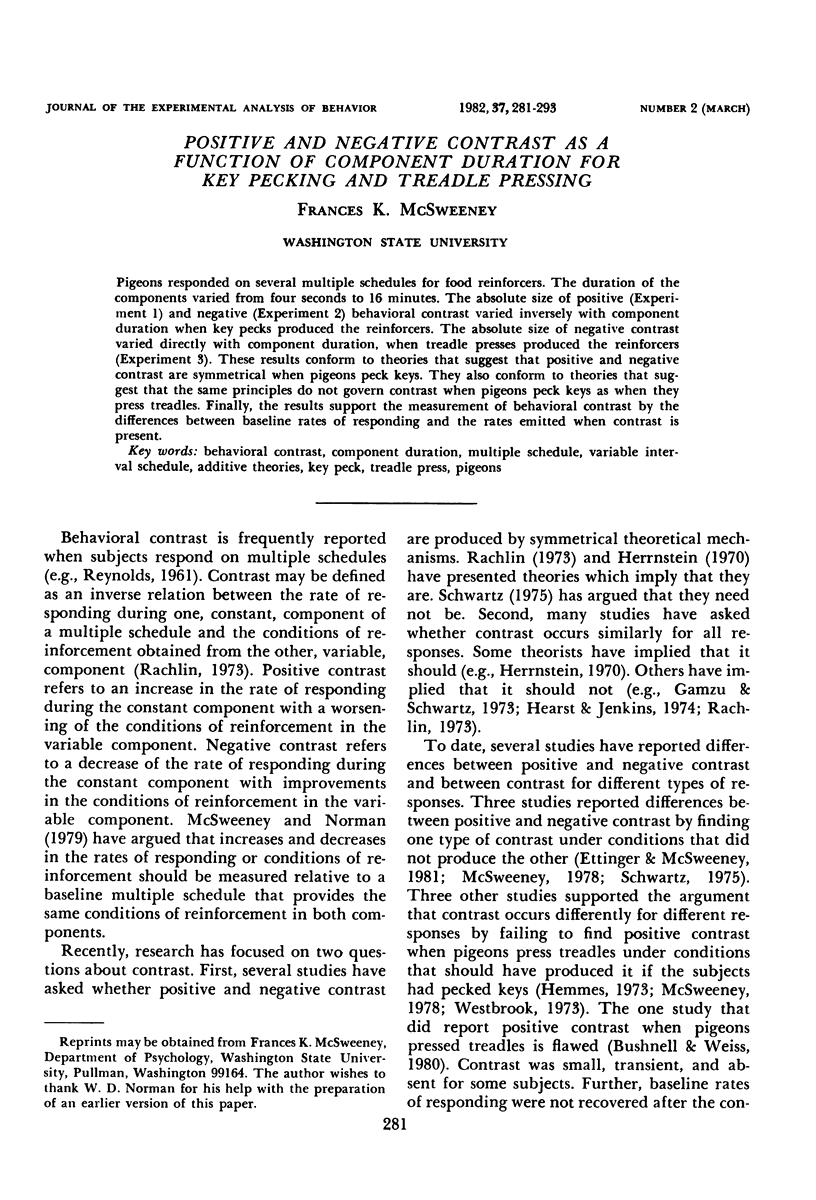

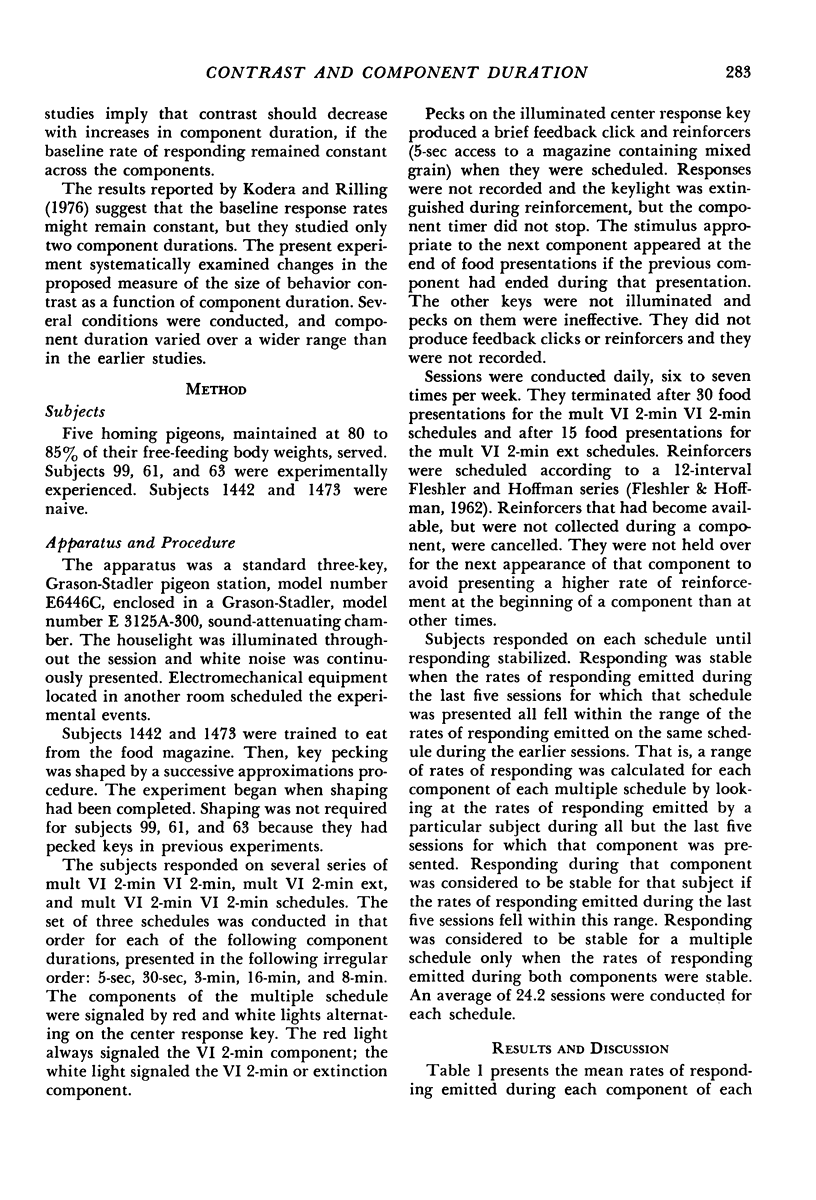
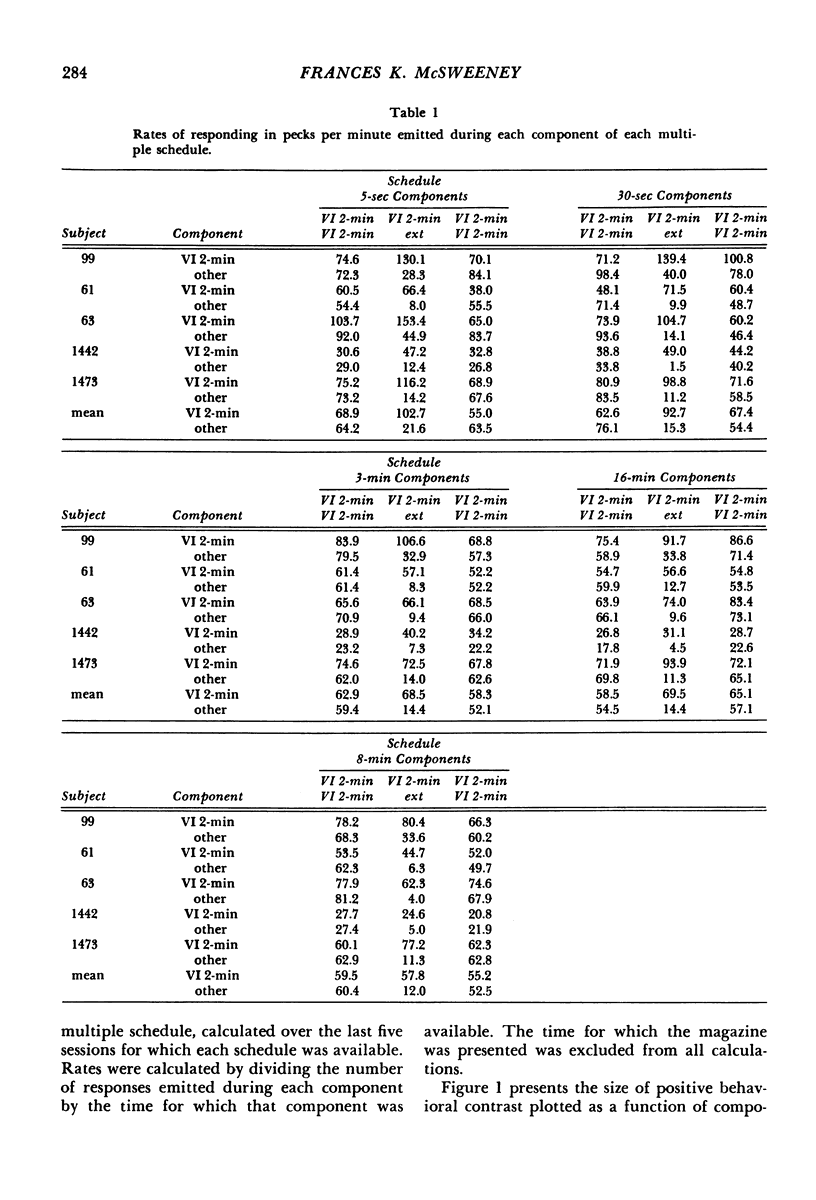
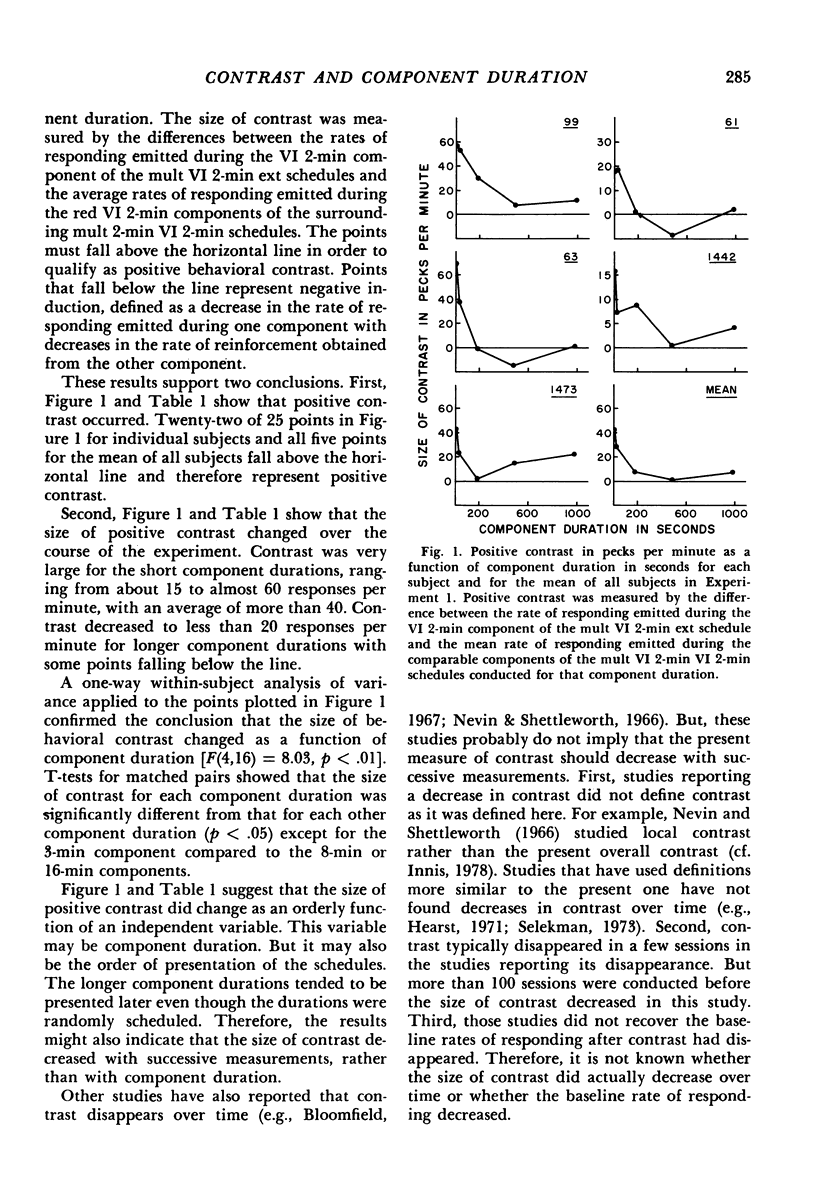
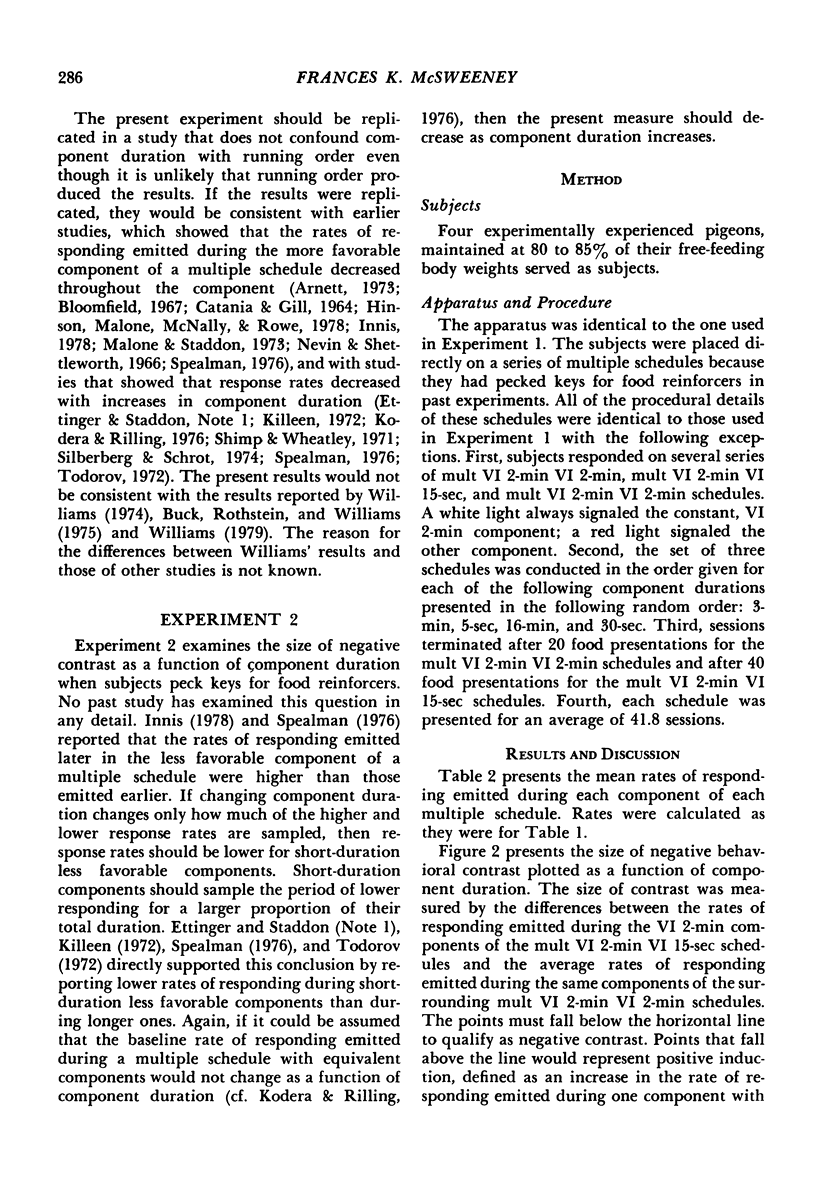
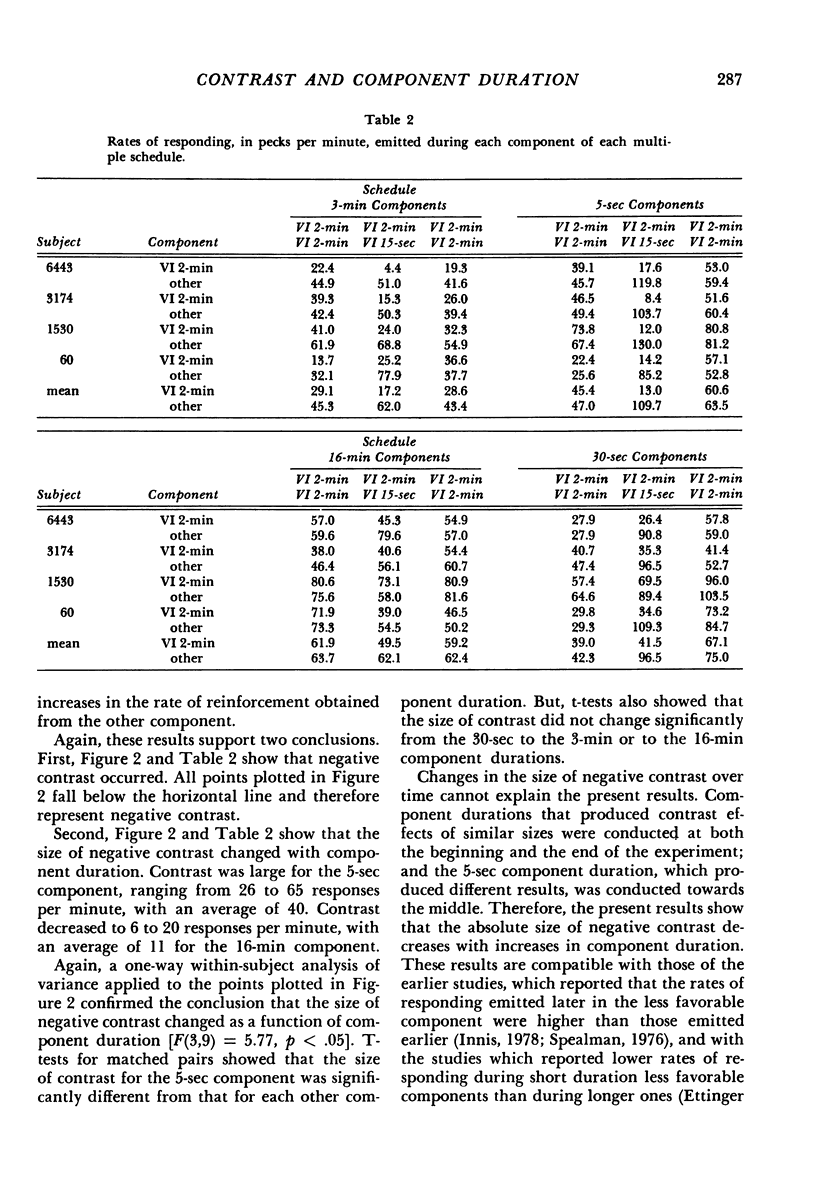
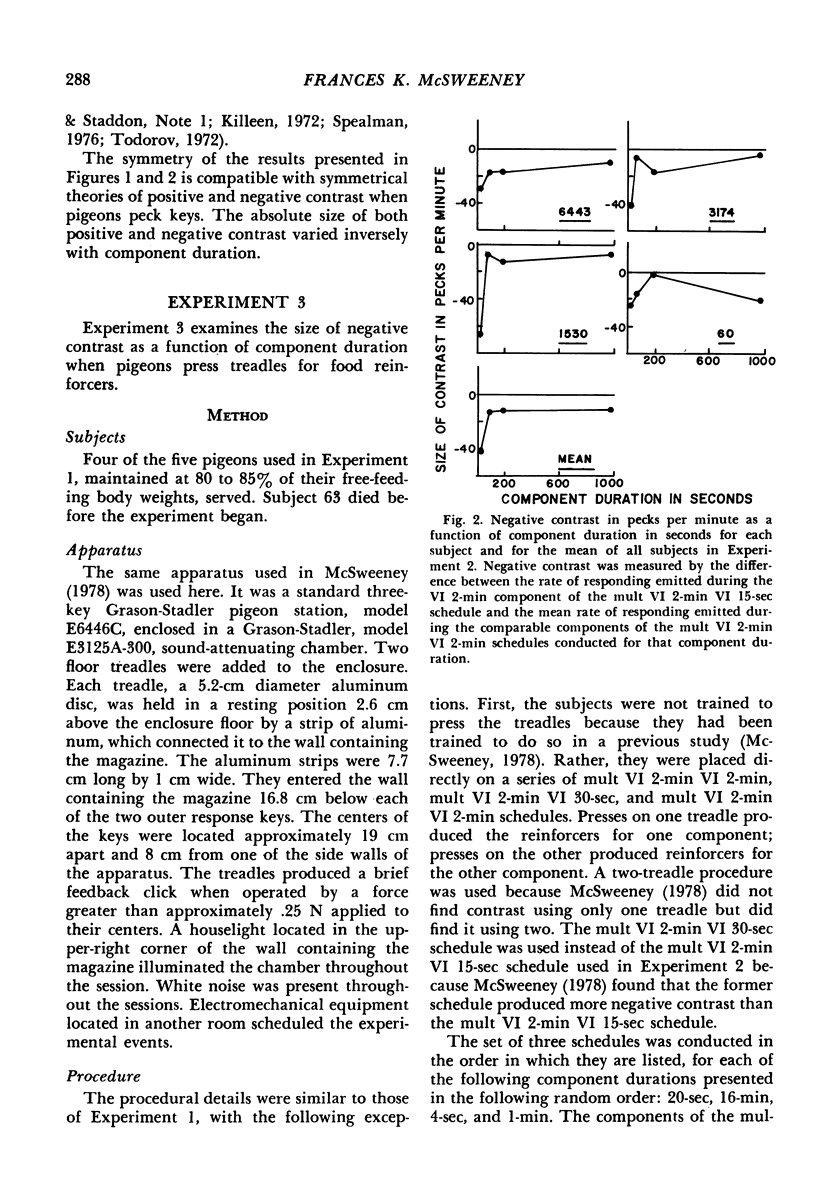
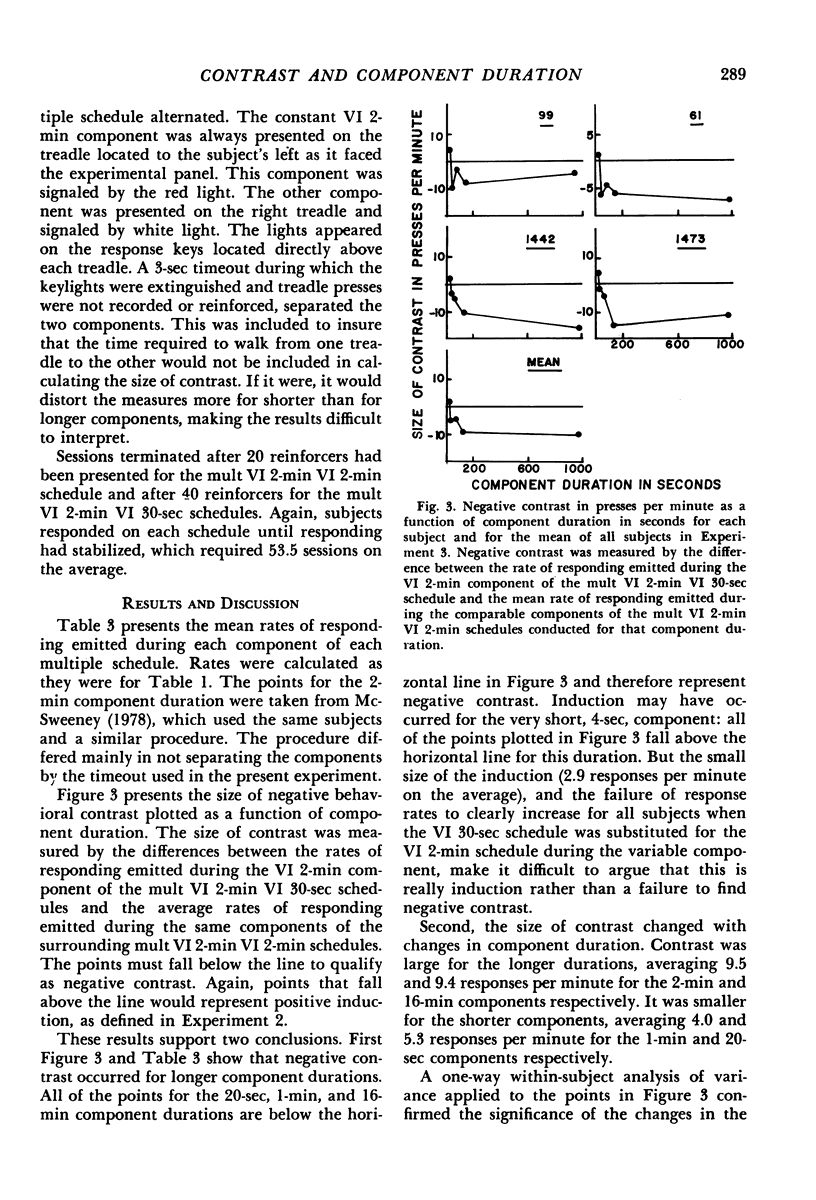
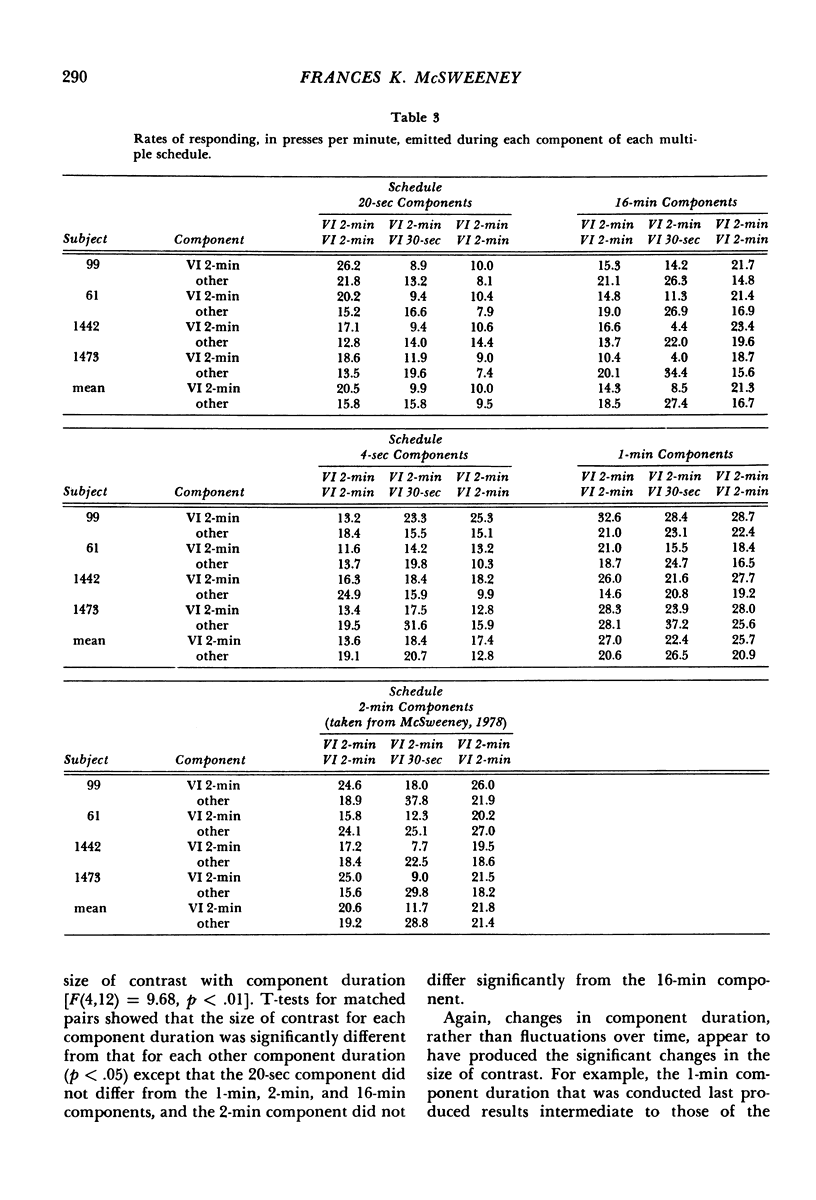
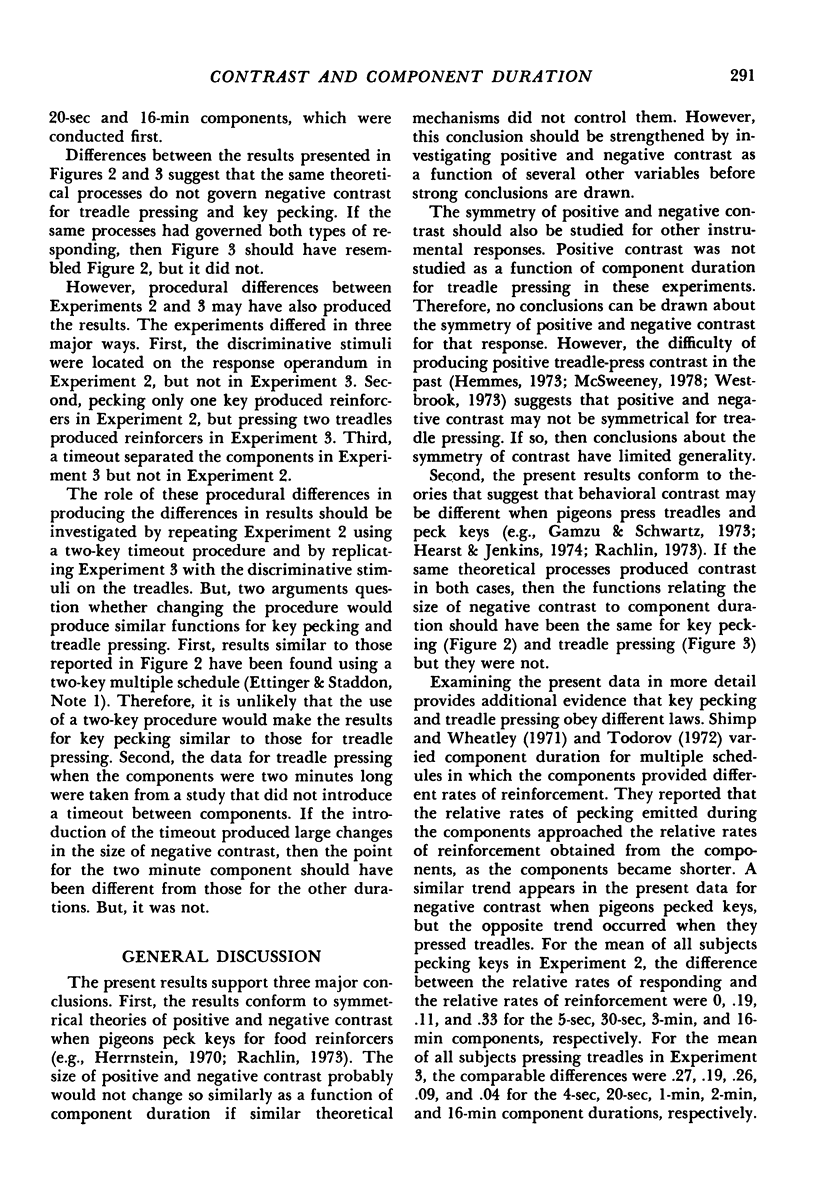
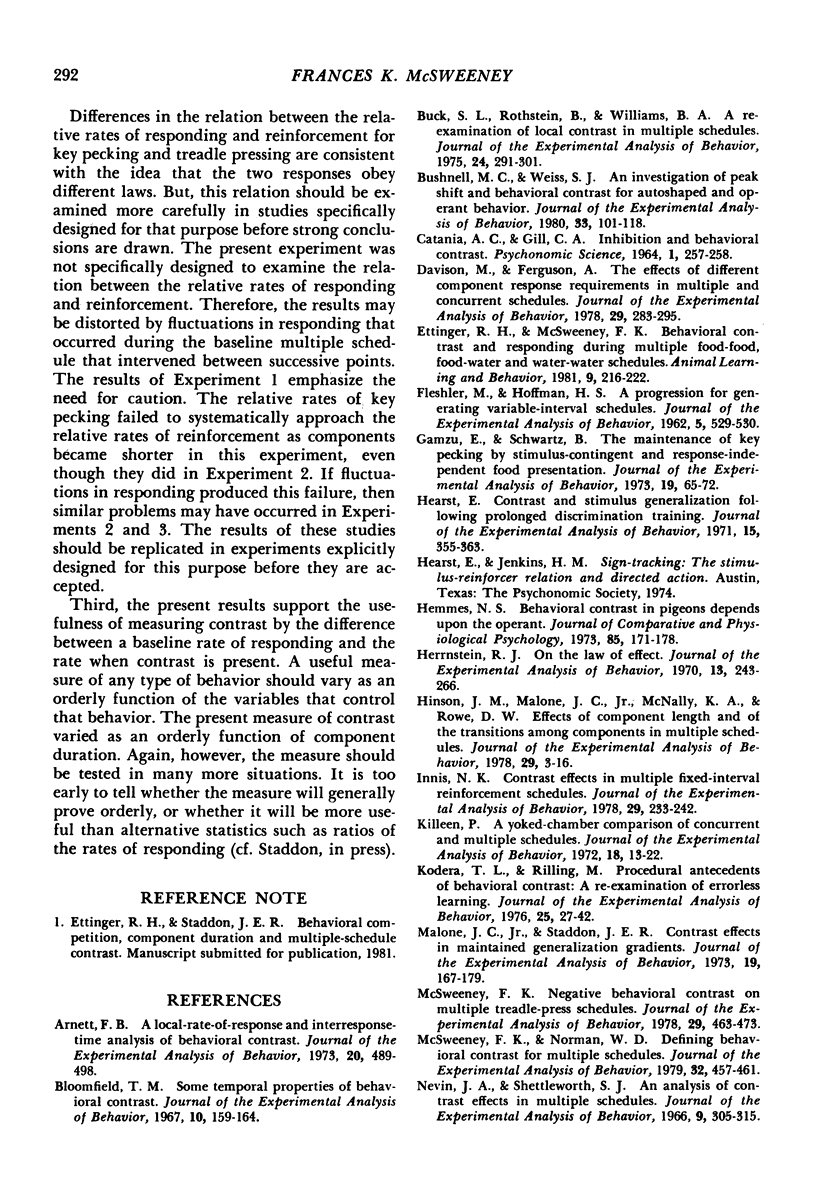
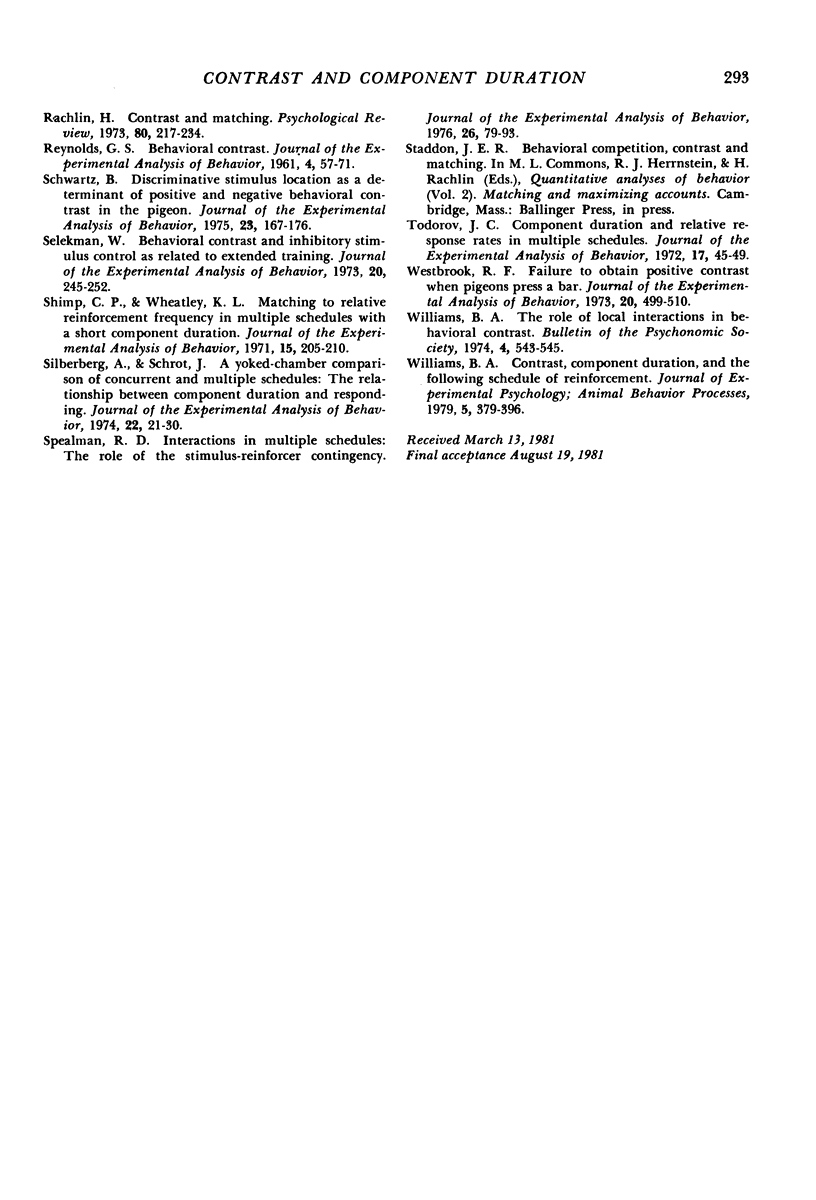
Selected References
These references are in PubMed. This may not be the complete list of references from this article.
- Arnett F. B. A local-rate-of-response and interresponse-time analysis of behavioral contrast. J Exp Anal Behav. 1973 Nov;20(3):489–498. doi: 10.1901/jeab.1973.20-489. [DOI] [PMC free article] [PubMed] [Google Scholar]
- Bloomfield T. M. Some temporal properties of behavioral contrast. J Exp Anal Behav. 1967 Mar;10(2):159–164. doi: 10.1901/jeab.1967.10-159. [DOI] [PMC free article] [PubMed] [Google Scholar]
- Buck S. L., Rothstein B., Williams B. A. A re-examination of local contrast in multiple schedules. J Exp Anal Behav. 1975 Nov;24(3):291–301. doi: 10.1901/jeab.1975.24-291. [DOI] [PMC free article] [PubMed] [Google Scholar]
- Bushnell M. C., Weiss S. J. An investigation of peak shift and behavioral contrast for autoshaped and operant behavior. J Exp Anal Behav. 1980 Jan;33(1):101–118. doi: 10.1901/jeab.1980.33-101. [DOI] [PMC free article] [PubMed] [Google Scholar]
- Davison M., Ferguson A. The effects of different component response requirements in multiple and concurrent schedules. J Exp Anal Behav. 1978 Mar;29(2):283–295. doi: 10.1901/jeab.1978.29-283. [DOI] [PMC free article] [PubMed] [Google Scholar]
- FLESHLER M., HOFFMAN H. S. A progression for generating variable-interval schedules. J Exp Anal Behav. 1962 Oct;5:529–530. doi: 10.1901/jeab.1962.5-529. [DOI] [PMC free article] [PubMed] [Google Scholar]
- Gamzu E., Schwartz B. The maintenance of key pecking by stimulus-contingent and response-independent food presentation. J Exp Anal Behav. 1973 Jan;19(1):65–72. doi: 10.1901/jeab.1973.19-65. [DOI] [PMC free article] [PubMed] [Google Scholar]
- Hearst E. Contrast and stimulus generalization following prolonged discrimination training. J Exp Anal Behav. 1971 May;15(3):355–363. doi: 10.1901/jeab.1971.15-355. [DOI] [PMC free article] [PubMed] [Google Scholar]
- Hemmes N. S. Behavioral contrast in pigeons depends upon the operant. J Comp Physiol Psychol. 1973 Oct;85(1):171–178. doi: 10.1037/h0034883. [DOI] [PubMed] [Google Scholar]
- Herrnstein R. J. On the law of effect. J Exp Anal Behav. 1970 Mar;13(2):243–266. doi: 10.1901/jeab.1970.13-243. [DOI] [PMC free article] [PubMed] [Google Scholar]
- Hinson J. M., Malone J. C., McNally K. A., Rowe D. W. Effects of component length and of the transitions among components in multiple schedules. J Exp Anal Behav. 1978 Jan;29(1):3–16. doi: 10.1901/jeab.1978.29-3. [DOI] [PMC free article] [PubMed] [Google Scholar]
- Innis N. K. Contrast effects in multiple fixed-interval reinforcement schedules. J Exp Anal Behav. 1978 Mar;29(2):233–242. doi: 10.1901/jeab.1978.29-233. [DOI] [PMC free article] [PubMed] [Google Scholar]
- Killeen P. A yoked-chamber comparison of concurrent and multiple schedules. J Exp Anal Behav. 1972 Jul;18(1):13–22. doi: 10.1901/jeab.1972.18-13. [DOI] [PMC free article] [PubMed] [Google Scholar]
- Kodera T. L., Rilling M. Procedural antecedents of behavioral contrast: a re-examination of errorless learning. J Exp Anal Behav. 1976 Jan;25(1):27–42. doi: 10.1901/jeab.1976.25-27. [DOI] [PMC free article] [PubMed] [Google Scholar]
- Malone J. C., Staddon J. E. Contrast effects in maintained generalization gradients. J Exp Anal Behav. 1973 Jan;19(1):167–179. doi: 10.1901/jeab.1973.19-167. [DOI] [PMC free article] [PubMed] [Google Scholar]
- McSweeney F. K. Negative behavioral contrast on multiple treadle-press schedules. J Exp Anal Behav. 1978 May;29(3):463–473. doi: 10.1901/jeab.1978.29-463. [DOI] [PMC free article] [PubMed] [Google Scholar]
- McSweeney F. K., Norman W. D. Defining behavioral contrast for multiple schedules. J Exp Anal Behav. 1979 Nov;32(3):457–461. doi: 10.1901/jeab.1979.32-457. [DOI] [PMC free article] [PubMed] [Google Scholar]
- Nevin J. A., Shettleworth S. J. An analysis of contrast effects in multiple schedules. J Exp Anal Behav. 1966 Jul;9(4):305–315. doi: 10.1901/jeab.1966.9-305. [DOI] [PMC free article] [PubMed] [Google Scholar]
- REYNOLDS G. S. Behavioral contrast. J Exp Anal Behav. 1961 Jan;4:57–71. doi: 10.1901/jeab.1961.4-57. [DOI] [PMC free article] [PubMed] [Google Scholar]
- Schwartz B. Discriminative stimulus location as a determinant of positive and negative behavioral contrast in the pigeon. J Exp Anal Behav. 1975 Mar;23(2):167–176. doi: 10.1901/jeab.1975.23-167. [DOI] [PMC free article] [PubMed] [Google Scholar]
- Selekman W. Behavioral contrast and inhibitory stimulus control as related to extended training. J Exp Anal Behav. 1973 Sep;20(2):245–252. doi: 10.1901/jeab.1973.20-245. [DOI] [PMC free article] [PubMed] [Google Scholar]
- Shimp C. P., Wheatley K. L. Matching to relative reinforcement frequency in multiple schedules with a short component duration. J Exp Anal Behav. 1971 Mar;15(2):205–210. doi: 10.1901/jeab.1971.15-205. [DOI] [PMC free article] [PubMed] [Google Scholar]
- Silberberg A., Schrot J. A yoked-chamber comparison of concurrent and multiple schedules: the relationship between component duration and responding. J Exp Anal Behav. 1974 Jul;22(1):21–30. doi: 10.1901/jeab.1974.22-21. [DOI] [PMC free article] [PubMed] [Google Scholar]
- Spealman R. D. Interactions in multiple schedules: the role of the stimulus-reinforcer contingency. J Exp Anal Behav. 1976 Jul;26(1):79–93. doi: 10.1901/jeab.1976.26-79. [DOI] [PMC free article] [PubMed] [Google Scholar]
- Todorov J. C. Component duration and relative response rates in multiple schedules. J Exp Anal Behav. 1972 Jan;17(1):45–49. doi: 10.1901/jeab.1972.17-45. [DOI] [PMC free article] [PubMed] [Google Scholar]
- Westbrook R. F. Failure to obtain positive contrast when pigeons press a bar. J Exp Anal Behav. 1973 Nov;20(3):499–510. doi: 10.1901/jeab.1973.20-499. [DOI] [PMC free article] [PubMed] [Google Scholar]
- Williams B. A. Contrast, component duration, and the following schedule of reinforcement. J Exp Psychol Anim Behav Process. 1979 Oct;5(4):379–396. doi: 10.1037//0097-7403.5.4.379. [DOI] [PubMed] [Google Scholar]


